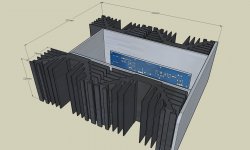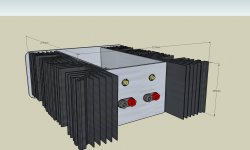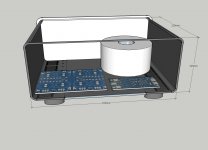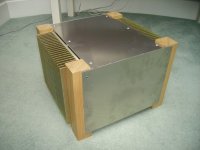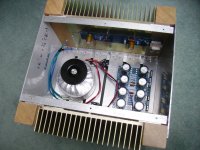say that proper temp difference between mosfet body and heatsink right ditto to mosfet is ok if within 10-15C range
it's hard to beat decent mica and goop , without going to more exotic stuff , of these Keratherm being easiest to obtain and use and practically the best thing
whatever you use - contact or laser meter , just take it with care and patience , thus no harm will be done
bias - keep it at 35W bay ( per mosfet) , for indefinite life
40W , if you are aware of every detail of thermal transfer ( practically - what's written above)
it's hard to beat decent mica and goop , without going to more exotic stuff , of these Keratherm being easiest to obtain and use and practically the best thing
whatever you use - contact or laser meter , just take it with care and patience , thus no harm will be done
bias - keep it at 35W bay ( per mosfet) , for indefinite life
40W , if you are aware of every detail of thermal transfer ( practically - what's written above)
Last edited:
Ok, will try to get some temp measurements tonight.
Here's specs on film at bottom of the page.
http://www.aavid.com/product-group/interface/films-insulating
Thanks,
Vince
Here's specs on film at bottom of the page.
http://www.aavid.com/product-group/interface/films-insulating
Thanks,
Vince
Last edited:
F6 mosfet does a lot of good things. Mids and highs are there with no added harshness or edge. Large images and depth /layers.
Very much like my F6 jfet, but a bit more laid back.
Very much like my F6 jfet, but a bit more laid back.
About 1.5 hrs of warm-up. When I took the lid off, it appeared to get warmer and warmer.
The temps in the 40 degree C range were taken last.
I don't think I will go higher with the bias since the room where the amp sits is cool in winter.
In summer it's not a hot room, but it's relevant to the season. All these temps could go closer to 55C, so this is good enough. .63 to .65v bias is good enough for me.
Laser temp probe
Case: 38 R, 36 L
HS: 36 R, 35 L
DMM probe
Case: 44 L, 49 R
HS: 32 R, 34 L
Thanks for the guidance.
Vince
The temps in the 40 degree C range were taken last.
I don't think I will go higher with the bias since the room where the amp sits is cool in winter.
In summer it's not a hot room, but it's relevant to the season. All these temps could go closer to 55C, so this is good enough. .63 to .65v bias is good enough for me.
Laser temp probe
Case: 38 R, 36 L
HS: 36 R, 35 L
DMM probe
Case: 44 L, 49 R
HS: 32 R, 34 L
Thanks for the guidance.
Vince
You're making me reconsider my somewhat more cavalier approach to biasing... Our ambient temp here is quite routinely around your case temp.  And admittedly when it's like that I don't turn a class a heater on all that often, but I'm pretty sure things have got over 60/70 deg C on the FET case before...
And admittedly when it's like that I don't turn a class a heater on all that often, but I'm pretty sure things have got over 60/70 deg C on the FET case before...
Well, nothing's blown up so far
 And admittedly when it's like that I don't turn a class a heater on all that often, but I'm pretty sure things have got over 60/70 deg C on the FET case before...
And admittedly when it's like that I don't turn a class a heater on all that often, but I'm pretty sure things have got over 60/70 deg C on the FET case before...Well, nothing's blown up so far

@aspringv: I have the same problem. Thinking that the store 4U Deluxe case won't quite make it. Maybe the 4U/400 case is an option, but then I would have to do the prep work on the rear plate myself, or pay for them to do it.
@henryve - I've found myself using 15VAC secondary instead of 18VAC. The difference in power isn't a deal breaker for me and the dissipation on the heatsinks is less, so that's a win for me.
That and I got the transformers for a song 😉
That and I got the transformers for a song 😉
You're making me reconsider my somewhat more cavalier approach to biasing... Our ambient temp here is quite routinely around your case temp.And admittedly when it's like that I don't turn a class a heater on all that often, but I'm pretty sure things have got over 60/70 deg C on the FET case before...
Well, nothing's blown up so far
I think temp depends on several factors. One is ambiant room temp, two is case and heat sink size and of course biasing. Other factors too. I believe if I were to get the mosfet case temp closer to 55 C, I would feel closer to a pain level on the heat sink side. It's about crossing a threshold, right?
Had a F3 where I could only hold my hand on it for 10 seconds max. It ran fine. Will it be around in 20 yrs? Who knows. I sold it, so there's no way for me to know. 😀
Last edited:
Braves souls run their amps closer to 60 C and higher. The IRFP240 can take a lot more with a shorter life of course. Unless I am mistaken some even go to 70 C. It is called hot rodding. The recommended 55 C is for commercial safety concerns and long life. Top fuel drag racers want their motors to last 3/4 mile at most. That is 3 races down the track and the norm a few years ago was 1/4 mile then rebuild. Nascar wants their motors to last 510 miles then blow up and build their motors to do just that. If they last much longer than that they lighten something inside to get more horse power.
starting my F6 build
I've assembled my parts and have begun plotting my F6 chassis design. I'm going for a stand-alone power supply using a Galaxy chassis. When I picked an enlosure for a MyRef amp, I chose a 2U 330x236 Galaxy chassis. In designing the F6 enclosures, I wanted to go with a similar footprint. The power supply is going to be built into a 3U 330x236 Galaxy enclosure. The output section is going to begin life as a 3U 330x230 Galaxy enclosure. The heatsinks are Wakefield 133 Series.
I've assembled my parts and have begun plotting my F6 chassis design. I'm going for a stand-alone power supply using a Galaxy chassis. When I picked an enlosure for a MyRef amp, I chose a 2U 330x236 Galaxy chassis. In designing the F6 enclosures, I wanted to go with a similar footprint. The power supply is going to be built into a 3U 330x236 Galaxy enclosure. The output section is going to begin life as a 3U 330x230 Galaxy enclosure. The heatsinks are Wakefield 133 Series.
Attachments
An advice;
Dont place any aluminium sheet, between cooler and mosfets.
But separately PSU is good idea.
Dont place any aluminium sheet, between cooler and mosfets.
But separately PSU is good idea.
Nice artwork!
If you build your own boxes you may even go for a dual mono setup. This can give more options with placing them.
Also you may want to consider to have two filter caps close to the boards - or even double the PSU Boards and move them to the amp boxes entirely.
If you build your own boxes you may even go for a dual mono setup. This can give more options with placing them.
Also you may want to consider to have two filter caps close to the boards - or even double the PSU Boards and move them to the amp boxes entirely.
An advice;
Dont place any aluminium sheet, between cooler and mosfets.
......
Why ? it's just a heat spreader...all you have to worry about is putting heat compound between sheet and heatsink.
Why ? it's just a heat spreader...all you have to worry about is putting heat compound between sheet and heatsink.
It will add to the thermal resistance of the transistor to heat sink junction.
It will add to the thermal resistance of the transistor to heat sink junction.
Absolutly right.! 🙂
Last edited:
- Home
- Amplifiers
- Pass Labs
- The diyAudio Firstwatt F6
